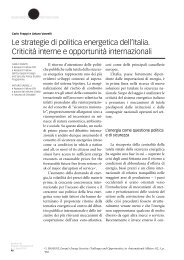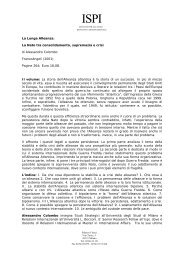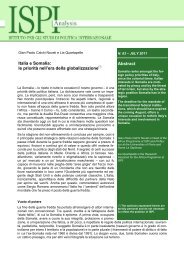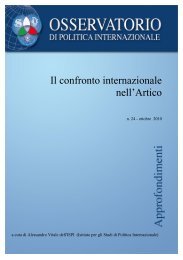heightened sectarianism in the middle east: causes, dynamics ... - Ispi
heightened sectarianism in the middle east: causes, dynamics ... - Ispi
heightened sectarianism in the middle east: causes, dynamics ... - Ispi
Create successful ePaper yourself
Turn your PDF publications into a flip-book with our unique Google optimized e-Paper software.
©ISPI2013external <strong>in</strong>terventions and <strong>the</strong> dom<strong>in</strong>ance of radical groups.Sectarianism lacks features that could make it a constructive orstabiliz<strong>in</strong>g force. It is based on conflict-oriented narratives, fed bymutual hatreds and victimizations. While <strong>the</strong>re are some hardl<strong>in</strong>eforces, such as <strong>the</strong> Islamic State <strong>in</strong> Iraq and Sham, that seekto establish a Sunni state all over <strong>the</strong> region, most o<strong>the</strong>r forces relate<strong>the</strong>ir sectarian solidarities to pragmatic or calculated purposes. Despite<strong>the</strong> <strong>heightened</strong> <strong>sectarianism</strong>, it would be wrong to ignore <strong>the</strong> <strong>in</strong>tracommunaldivides that, if taken seriously, might question <strong>the</strong> very existenceof sectarian community. Political, ideological, regional and tribaldivisions are concealed or made <strong>in</strong>visible by <strong>the</strong> Sunni-Shi’a tensions,but <strong>the</strong>y could be awakened as soon as <strong>the</strong>se tensions de-escalate.Therefore, sectarian groups and <strong>the</strong>ir sponsors have an <strong>in</strong>terest <strong>in</strong>ma<strong>in</strong>ta<strong>in</strong><strong>in</strong>g sectarian divides. Aga<strong>in</strong>, it is a question of power. It determ<strong>in</strong>es“who controls <strong>the</strong> group” which is equivalent to who “def<strong>in</strong>es<strong>the</strong> group”.The com<strong>in</strong>g years are likely to see <strong>the</strong> cont<strong>in</strong>uity of difficult coexistencebetween sectarian identities and <strong>the</strong> ‘state’ <strong>in</strong> <strong>the</strong> region. The “fragilestates” whose number has <strong>in</strong>creased follow<strong>in</strong>g <strong>the</strong> “Arab Spr<strong>in</strong>g”, are<strong>the</strong> outcomes of <strong>the</strong> failure of nation-build<strong>in</strong>g processes and developmentapproaches <strong>in</strong> <strong>the</strong> region. However, replac<strong>in</strong>g <strong>the</strong> fragile stateswith those based on sectarian identities will only complicate <strong>the</strong> currentconflicts. The problem does not lie <strong>in</strong> <strong>the</strong> existence of multiple religiousand sectarian identities, but <strong>in</strong> <strong>the</strong> politics of exclusion. Nomatter how powerful <strong>sectarianism</strong> seems to be today, it cannot represso<strong>the</strong>r social cleavages that might emerge aga<strong>in</strong> if <strong>the</strong> exclusiontook o<strong>the</strong>r forms. Any solution for sectarian conflicts <strong>in</strong> <strong>the</strong>region must beg<strong>in</strong> with <strong>the</strong> understand<strong>in</strong>g that <strong>the</strong>se conflicts arenot about religious doctr<strong>in</strong>es. They are about power and social status<strong>in</strong> contexts where large social sectors have been denied accessto <strong>the</strong>m.Solutions have to be based on broad regional agreement to stop us<strong>in</strong>gsectarian <strong>in</strong>stigation as a tool of <strong>in</strong>fluence and mobilization.Ideologies of sectarian hatred must be banned and condemned on<strong>the</strong> global level. In addition, solutions should not be based on emphasiz<strong>in</strong>gand <strong>in</strong>stitutionaliz<strong>in</strong>g sectarian identities, as was <strong>the</strong>case with <strong>the</strong> k<strong>in</strong>d of ‘democratic’ consociationalism applied <strong>in</strong>Lebanon and Iraq. This is a model that susta<strong>in</strong>s socio-cultural divisionsand perpetuates <strong>the</strong> power of sectarian entrepreneurs.The viability of <strong>sectarianism</strong> <strong>in</strong> <strong>the</strong> Middle East is largely dependenton <strong>the</strong> potential transformations of socio-cultural conditionsthat permitted its recent growth <strong>in</strong> <strong>the</strong> first place. Address<strong>in</strong>g <strong>the</strong>Despite <strong>the</strong> <strong>heightened</strong><strong>sectarianism</strong>, it would bewrong to ignore <strong>the</strong> <strong>in</strong>tracommunaldivides that, iftaken seriously, mightquestion <strong>the</strong> very existenceof sectarian community.Political, ideological,regional and tribaldivisions are concealed ormade <strong>in</strong>visible by <strong>the</strong>Sunni‐Shi’a tensions, but<strong>the</strong>y could be awakened assoon as <strong>the</strong>se tensions deescalate9
















